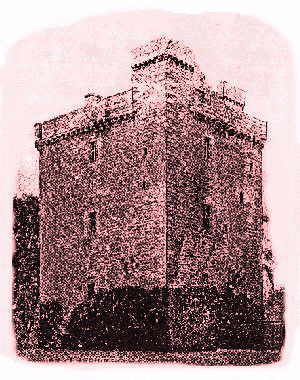
The castle as it looked around 1912, viewed from the South-east. It is now hardly visible from outside the private grounds in which it is situated except during winter when only its dark outline can be seen amongst the bare trees in winter.
The graphic file is 119k and 640x882 pixels.
|
Some browsers will allow you to see a larger version of the floor-plan graphics below by right-clicking on the mouse and choosing the "zoom in" feature. |
Ministry of Public Building and Works Affleck Castle
|
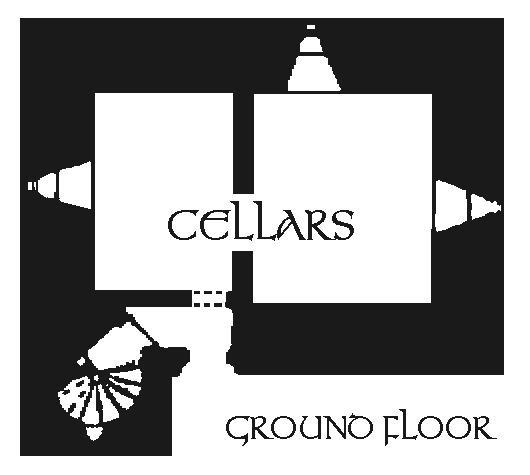 |
The doorway is in the re-entrant angle, sheltered by the projecting "jam" and covered by a projecting post on the parapet above. There are at present no machicolations, or openings, between the corbels of this projection, but there can be little doubt that these were present before the parapet was reconstructed. Within the door a short passage gives access on the left to the stair foot, and in front to the cellarage on the ground floor of the main building. This is divided into two by the cross-wall, and is lit only by narrow loops. The cellars are ceiled by the wooden floor of the storey above. |
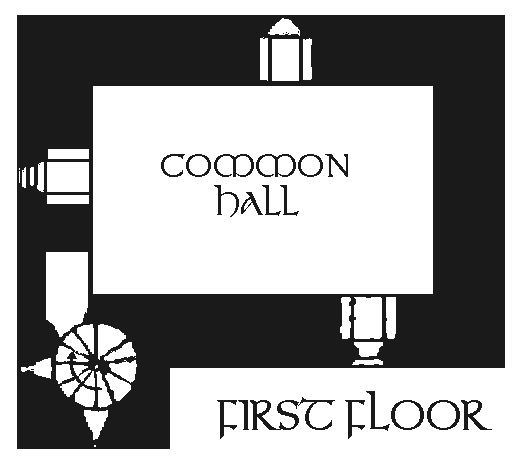 |
This storey is reached by the
spiral staircase, and formed the common hall of the
castle. It is vaulted, and has three good-sized windows,
with stone benches in their bays; but otherwise the room is
comfortless enough, having neither fireplace nor sanitation.
Above this level the floors are all of wood. |
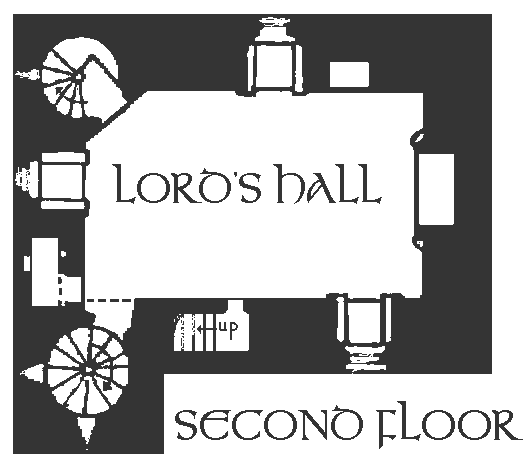 |
The spiral stair continues up to the second floor, which formed the lord's hall. This is a fine apartment. The dais, or low raised platform, on which stood the lord's table, was at the north or upper end, and behind it is a large handsome fireplace. The windows have side stone benches, and beside the entrance is a latrine. At the north-west corner is a large wall-press. At this level the main stair in the "jam" stops, and to reach the upper floors we have to cross the hall to the opposite corner, where another spiral stair ascends to the roof. Thus anybody wishing to reach the battlements would have to cross the hall in full view of the household. Owing to this ingenious arrangement, adopted doubtless with an eye to security, the upper part of the "jam" is available for small chambers. |
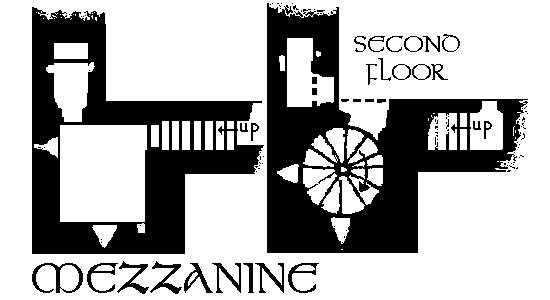 |
The first of these is reached by a narrow, straight mural stair opening in the east wall of the hall. it is a mere cell, with two loopholes and a nook for a lamp. Off it is a neat latrine, and from this a tiny peep-hole enables the inmate to the little room to keep an eye on the hall below. |
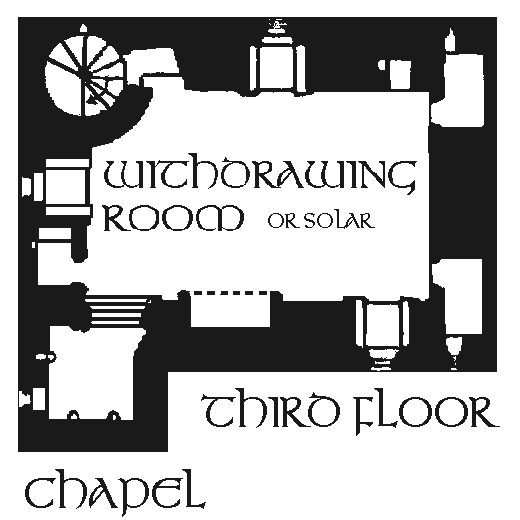 |
The floor above the lord's hall
contains the solar or withdrawing room, the principal apartment in
the castle. This is a room of exceptional distinction, and
despite its small size it has few equals in Scotland. The
windows are large and finely formed, with stone side benches, and
the great fireplace has moulded jambs in the rich style of the
fifteenth century. there is a latrine, and there are large
mural closets, which might contain bunks, in the north end wall as
well as a wall-press at the north-west corner.
At the south-west corner, an arched opening admits to a singularly beautiful chapel. This opening is treated as a miniature chancel arch, the jambs having curved bases and moulded caps, while the arch has a wide hollow moulding. On the ingoings of the jambs will be noticed the chases for a wooden screen. Just inside, on the right is a holy water stoup, corbelled out into a heptagonal form, with shields carved in relief upon the sides. One of these shields displays three lozenges. The chapel is vaulted in fine ashlar, and is lit by a charming little window, with a trefoiled head and stepped sole. Against the east wall stood the alter, and on either side there remain in the wall two richly-moulded corbels, no doubt for carrying candles or images. Beside the alter is an aumbry. In the south wall is the piscina, the bowl in which the priest rinses out the chalice after Mass. This is a perfect little gem in its way. The projecting basin is richly moulded, and springs from a corbel in the form of a human mask. Above it is a pointed arched recess, which contained the cruets of wine and water. Over the head of the arch are three consecration crosses. Nothing could be more satisfying than the effect produced by this chapel, and its perfect condition give it an impression of scale that belies its small dimensions. |
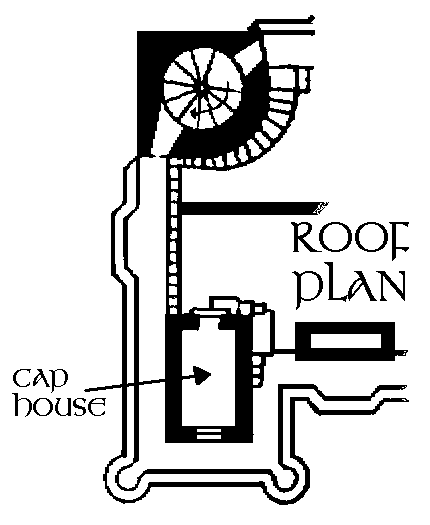 |
The spiral stair in the south-west of the solar continues up to the battlements. In the cap-house over the "jam" is a small chamber entered from the wall-walk. The battlements on both cap-houses are reached by narrow open stairs. |
The accommodation provided in Affleck Castle is that of a normal small medieval house: - cellarage, common hall, lord's hall, solar and chapel: but it is up-ended for security reasons, and we therefore see here very clearly how the tower-house is nothing else than an ordinary house with its rooms piled on top of each other on account of the need for defence. There is no kitchen, and the cooking must have been done in an outbuilding within the barmkin wall, by which such towers were invariably enclosed. If need be, the lord's hall fireplace could have been used, but omission of a kitchen is remarkable in a tower otherwise so complete and well furnished in all its parts.
Printed and published by
Her Majesty's Stationery Office
Crown Copyright reserved (Reprinted 1969) 3d. net
Dd 239004 K7 Ed
(5736) - SBN 11 4901 60 0
|
For your information:- |
LOCAL INTEREST ¤
FAMILY HISTORY INTEREST ¤
NEWBIGGING INTEREST ¤
ARLENE'S LISTS ¤
LOCAL BUSINESS ¤
'DOWN THE AGES'
CHURCH PAGES ¤
CHURCH MAGAZINE ¤
OLD BOOK EXTRACTS ¤
STIRLING SURNAME ¤
MONIKIE MEMORIAL HALL ¤
'THE MONIKIE STORY'
WEB PAGES LIST ¤
SEARCH THIS WEBSITE ¤
HOMEPAGE ¤
CONTACT & EMAIL
Please press the BACK BUTTON for your previous page.